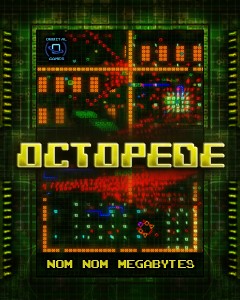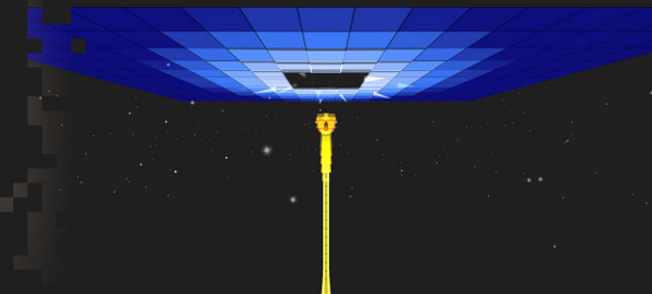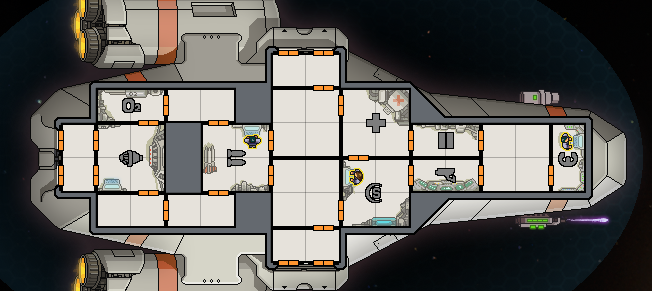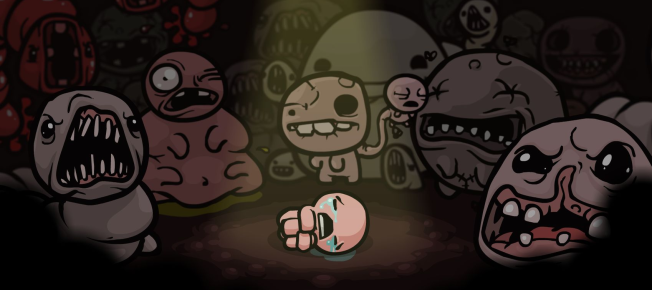As video games have evolved from generation to generation, they have taught a sort of language along the way – not just of jargon, but of mechanics and muscle-memory. Usually, this works to the long-time gamer’s benefit, as new titles build upon the “rules” established by their predecessors. It’s why you can pick up a side-scrolling platformer and trust your impulse to start moving to the right, or start a bullet-hell shooter and – well, hope, at least – that a safe haven is hiding somewherewithin the screenfull of ammunition. It’s why you can sit down to a new PC game and find your left hand settling on the WASD keys, or why you can pick up a console shooter and expect the left analog stick to move your character while the right aims your weapon. Conventions are invented, then refined, then repeated, until they become instinct.
As a result, there is an uneasy tension between gaming’s past and present. The savvy game designer can take advantage of historical conventions, either to rely upon them or subvert them. But invoking the past always carries with it certain risks. A game that stays too close to what has come before comes off as a soulless copy, while a game that changes a historical model too much forces players to fight against their own expectations.
Which brings us, in a roundabout way, to Octopede, a recent title from British developer Orbital Games.
On its surface, Octopede is a riff on the 70s arcade classic Snake. Cast in the role of a “rogue computer worm,” you race through a neon simulation of a computer interface, collecting data packets as you dive your way down to the system’s core. Every datum you collect adds another segment to your avatar’s tail, creating a clear visual throughline linking Octopede to its spiritual predecessors. But appearances can be deceiving. In practice, Orbital has made so many deviations from the archetype’s conventions that the comparison to Snake almost becomes dangerous, resulting in a game that requires the player to overcome, rather than draw upon, some of their past experiences with the genre. The end product is still enjoyable, but that enjoyment requires you adapt to some uncomfortable breaks from tradition – unfortunately, a process at which I never quite managed to succeed.
Visually, Octopede is far more active than Snake ever was, thanks to the introduction of an array of enemy viruses that riddle the system. The enemy AI is very straightforward – some move along set paths, other shoot you from afar, still others chase you across the screen – but such simple adversaries are threatening when thrown at you by the handful. Fortunately, you’re offered a variety of tricks to use against them, ranging from the ability to shoot in the direction you are moving to traps you can leave in your wake. There are also special weapons to collect and use, each of which can be counted on for mass destruction when you find yourself in a pinch. Darting around the screen, trying to collect data packets and ammo while dodging and dogfighting your enemies certainly makes for an exciting, arcade-inspired experience – albeit one that feels more akin to retro shooter like Geometry Wars than a traditional game of Snake. Clean, pixellated graphics and chiptune music/SFX complement both this gameplay and the framing story, although I found myself wishing the different enemy types were more visually distinct and that the debris effects that occasionally clutter the screen were less invasive.
This experience is enhanced by the game’s central scoring mechanic, which is perhaps its best element. Whenever you pick up data packets and extend your worm’s length, you are building up your health reserves as well as earning points – you lose segments when your worm’s head is damaged, and you die when you have nothing left to lose. However, whenever you have more than eight segments trailing you, you can choose to “cache” them, permanently giving up their utility as health in exchange for increasing your score multiplier. Judicious caching is a must if you want to climb the leaderboards, but it always comes at the cost of permanently ceding part of your safety – a classy implementation of risk versus reward. Building an arcade game around the tension between survivability and score is a great idea, and Orbital has executed it well.
Yet, perhaps to make room for all these new additions that are demanding part of your screen’s limited real estate, Octopede abandons the defining element of Snake’s gameplay: the idea that colliding with your own tail is fatal. The potential for self-destruction informs every instinct I have when playing Snake, not to mention popular culture’s most enduring image of the genre – the iconic visuals of Tron’s lightcycle racing. But, in Octopede, your tail is mostly cosmetic: aside from one enemy that targets the end of your tail, the game would play rather the same without it. Any Snake veteran will probably find this a little disorienting. In my case, I found myself constantly fighting my instinctual self-avoidance, and I’m sure I died a few needless deaths that I could have survived had I remembered that my own tail wasn’t lethal. Taking the game on its own merits, this is a wholly acceptable design choice – indeed, the game would probably be unplayable if you had to avoid your tail and all the other hazards of the mainframe – and I adapted to the change fairly quickly. But when so much of the game’s backbone is derived from the Snake tradition, I was thrown for a moment when I realized what had been lost along the way.
Less forgivable is the game’s awkward control scheme. Orbital boasts that Octopede lets you move in eight directions, giving you an edge over the strict up-down-left-right movement of your enemies. I liked this idea in theory, but in practice Orbital has made it nigh-unworkable. On the keyboard, cardinal movement is controlled by the directional arrow keys, but diagonal movement is inexplicably assigned to the WASD keys rather than to the more-conventional combinations of the arrow keys. (In other words, rather than pressing both up and left to move in the up-left diagonal, you press the A key.) If there is a logic underlying the mapping of diagonals-to-letters then I never found it, and all the while I struggled to master two-handed movement while also trying to trigger weapons and cache excess data. Frustrated, I switched to using an Xbox controller, only to find a new iteration of the same problem – rather than assigning eight-directional movement to a single analog stick, the game parcels movement across them both. Granted, you can control everything with a single hand via your keyboard’s numpad, an option that might help those familiar with such a movement array, but unfortunately that’s a gaming language I’ve never learned.
Using both hands to control the worm’s movement was so alien to me that I ultimately abandoned hope. Rather than struggling further with the eight-directional options with which I was presented, I just trusted my years of four-directional intuition to keep me safe and ignored the diagonals entirely. I acknowledge that part of the problem here was my own fault, my own inability to adapt. But when making a game that holds itself out as an evolution of a video game classic, I would have expected Octopede to default to something closer to more conventional, instinctual controls, to let players like me take advantage of behavior honed over decades rather than forcing us to resist our mental conditioning. Is this irony, then—that Octopede abandoned the Snake tradition of making my body my worst enemy, only to make me fight myself in order to play it? (Orbital has, to their credit, stated elsewhere that they rejected single-stick control during the design process but that it will be added via the next update. I may not agree with the former decision, but I commend them for the latter.)
In the end, once I got myself into the mindset of playing a score-driven shooter rather than a direct Snake homage, learned how to best use my offensive and defensive items, and accepted that eight-directional movement was going to remain an unrealized dream for me, I had a good time with Octopede. The action is fast-paced, the atmosphere is invitingly old-school, and the caching mechanic is surprisingly intelligent – in my opinion, the game’s biggest strength. Fans of the genre will find a lot to like, and anyone who tries the demo and finds themselves wanting more should find the game well worth the three-dollar cost. But I can’t help but feel that the game might have been better if Orbital had been a little more confident in their game’s ability to stand on its own, designing and framing it as an independent experience rather than as the “evolution” of a classic. Invocations of gaming history carry with them a certain amount of baggage; here, the specter of Snake weighs down an otherwise-well-made arcade experience.
Octopede, by Orbital Games, is available via Desura for the PC and will be coming soon to Xbox Live, Steam, and a number of other gaming providers. Reviewed for 3+ hours, including two successful trips to the system’s core and many adventures along the way—all without moving diagonally.
Overall Rating: 




© 2011 – 2013, The Indie Mine. All rights reserved.






Hi,
Thanks for the great review!
We have taken your controls ‘input’ (see what I did there?!) to mind and have updated Octopede with the ability to set the Left stick of a 360 controller to move in all 8 Directions.
The updated builds are being uploaded to Desura as I write this, and once they have been approved, users will be able to download / update to get the new changes.
This new movement mode is turned on via the “Left Stick 8 Dir” option in the options menu.
Thanks again for a great review and for playing Octopede!
Andy Longhurst
Director and Programmer – Orbital Games
Andy, I really appreciate you taking my comments to heart. I’ll post some follow-up thoughts once I’ve had the chance to try out the new controls.
Thanks for weighing in Andy. Will definitely be giving this one a try when it comes to Xbox Live.
Jeff I have received an email from Desura saying the new build has been approved so you should be able to download it now.
Use a gamepad at the splash screen and then select “Left Stick 8 Dir” from the options menu to activate the new scheme. It works best if you hold the stick down to guide the snake instead of flicking it when you want to change direction.
I’ve written up some thoughts regarding the control system, and you inspiring us to update them: http://orbitalgames.co.uk/2011/11/thoughts-on-octopede-control-system/
Brandon as far as the XBL version goes, I’m waiting for an Xbox 360 memory unit to arrive so I can get rid of the last storage bugs on Xbox. I’ll then submit it for peer review and after about 2 weeks it should be live in the Indie arcade!
Stay posted, and thanks for the support!
Andy Longhurst
Octopede is now available in the Xbox Live Indie Games Marketplace for only 80 MSP. Check it out: http://www.google.com/producer/editions/CAowpNtH/the_indie_mine
Thanks Brandon. Although I think you may have posted the wrong link there :p
http://marketplace.xbox.com/en-US/Product/Octopede/66acd000-77fe-1000-9115-d80258550a4e
Hah, thanks for catching that. Was a little copy-paste happy earlier.